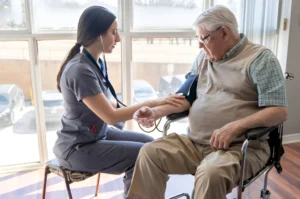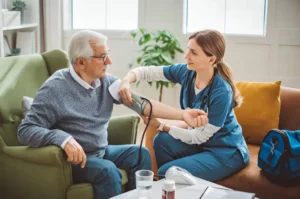COVID-19 has reshaped the way we live our lives. Over the last few weeks we have witnessed alarming increases in the rate of infection and deaths across the United States due to the Pandemic. The numbers have been increasing in New York State as well. Therefore it is vital to continue practicing healthy behaviors to prevent greater risk of infection in our communities.
The best way to protect those we care for is for caregivers to take care of themselves. Caregivers spend the most time with patients and therefore need to take equal precautions from becoming sick or asymptomatic. Here are some suggestions that will help both caregivers and patients stay safe.
Encourage Healthy Practices. Both caregivers and patients should follow CDC recommendations as well as local and state guidelines regarding the prevention and spread of COVID-19. Make the following behaviors routine:
- Avoid unnecessary outdoor activities
- Continue to wear a mask if you need to step out of your home
- Avoid large gatherings and, where possible, maintain the recommended six feet of space from people
- Avoid touching your face when outdoors or with unclean hands
- Change your clothes when returning from the outside
- Wash hands frequently
- Cover your mouth and nose when sneezing
- Periodically open windows to circulate the air
- Frequently clean surfaces that are high touch areas such as doorknobs, bathrooms, and the refrigerator door
Keep Fit and Eat Well. Maintaining good health isn’t only about avoiding germs; it’s about maintaining a wellness routine that keeps your mind and body fit to fight off infections and disease. Although there currently isn’t a vaccine for COVID-19, now is an excellent time to revisit the dietary and exercise practices to ensure that caregivers and patients are in optimal
health.
- Increase the intake of fresh food that will give you the necessary vitamins, minerals, fiber, protein, and antioxidants your body needs to keep you healthy
- Drink plenty of water
- Encourage physical exercise, depending on your patient’s abilities. Stretching and chair exercises are great alternatives if a patient is unable to go out for a walk while maintaining distance from others.
- Destress with scheduled meditation and deep breathing exercises for a few minutes a day
Connect. Smartly. As social beings, human interaction is an essential part of lives. Caretakers should leverage technology to connect patients with the people and groups that make them feel happy, appreciated, and less isolated.
- Schedule regular catchups with family and friends via phone and video conference tools such as WhatsApp, Zoom, and Google Meet. Additionally, have your patient do online check-ins with any children who are close with your patient. Studies show that engaging with children has a positive impact on both elderly and kids
- Encourage the use of smartphones, tablets, and computers to join virtual groups that align with patient interests. Many groups and classes are made available through local organizations such as community centers, houses of worship, and professional organizations
- Join virtual support groups offered by healthcare or insurance providers. They are a therapeutic way to connect with others, share your feelings and state of mind, and may help caregivers and patients navigate these complicated times
Plan Ahead to Minimize Contact with Others. Businesses have done a great job adjusting to the new contactless reality, and there are many safe ways to ensure the basic needs of patients.
- Stock up on essential items by maintaining a one-month supply of food, non-perishables, medications, personal hygiene items, and other supplies. This will limit the need for a patient to venture to the market
- Setup online delivery or curbside pickup. Pharmacies, including local and big-name brands, are participating in contactless deliveries, and sites such as Peapod, Instacart, Shipt, and Amazon Prime, simplify access to groceries
Have a Medical Emergency Plan. For most patients, access to medical care is a routine part of their lives. Have a plan in place which will ensure uninterrupted healthcare, especially during an emergency.
- Call 911 for any life-threatening needs
- Cancel any unnecessary in-person appointments (ask your medical professional if there are questions as what these are)
- Become familiar with how the patient’s primary medical office is engaging with patients. Some offices are allowing appointments under certain conditions, and many are using telemedicine for scheduled appointments. Whatever the method, have the proper applications downloaded, and maintain the preventative behaviors mentioned earlier.
- Before a medical emergency, become familiar with the check-in process at your local hospital in case patients need to adhere to specific rules




